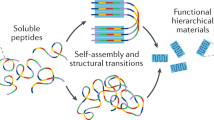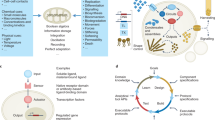Abstract
A new generation of biomaterials will, by design, harness the power of surfaces to direct specific processes
This is a preview of subscription content, access via your institution
Access options
Subscribe to this journal
Receive 12 print issues and online access
$209.00 per year
only $17.42 per issue
Buy this article
- Purchase on Springer Link
- Instant access to full article PDF
Prices may be subject to local taxes which are calculated during checkout
Similar content being viewed by others
References
Los Angeles Times, 14 Oct 93, Home Edition, Page A-l.
Whitesides, G.M., Mathias, J.P., Seto, C.T. 1991. Molecular self-assembly and nanochemistry: A chemical strategy for the synthesis of nanostructures. Science 254: 1312–1319.
Lehn, J.M. 1993. Supramolecular chemistry. Science 260: 1762–1763.
Lehn, J.M. 1988. Supramolecular chemistry - scope and perspectives: Molecules, supermolecules, and molecular devices (Nobel Lecture). Angew. Chem. Int. Ed. Engl. 27: 89–112.
Lehninger, A.L. 1975. Biochemistry. Worth Publishers, Inc., New York.
Israelaehvili, J.N. 1985. Intermolecular and Surface Forces. Academic Press, New York.
Norde, W., and Lyklema, J. 1992. Why proteins prefer interfaces. In The Vroman Effect, C.H. Bamford, S.L. Cooper, and T. Tsuruta, eds., VSP, Utrecht, Netherlands.
Kreshech, G.C., and Klotz, I.M. 1969. The thermodynamics of transfer of amides from an apolar to an aqueous solution. Biochemistry 8: 8
Bodmeier, R., Chen, H., Tyle, P., and Jarosz, P. 1991. Spontaneous formation of drug-containing acrylic nanoparticles. J. Microencapsulation 8: 161–170.
Harmia-Pulkkinen, T., Tuomi, A., and Kristoffersson, E. 1989. Manufacture of polyalkylcyanoacrylate nanoparticles with pilocarpine and timolol by micelle polymerization: factors influencing particle formation. J. Microencapsulation 6(1): 87–93.
Adams, S.E., Senior, J.M., Kingsman, S.M., and Kingsman, A.J. 1988. Induction of HIV antibodies by Ty: HIV hybrid virus-like particles. In Technological Advances in Vaccine Development, Alan R. Liss, New York.
U.S. Patent ♯ 5,178,882, 12 January 1993. and U.S. Patent ♯5,219,577,15 June 1993. are assigned to the University of California. Others are pending.
The modification of nanoparticles with a carbohydrate monolayer described here should be distinguished from the technique of Schröder et al. (U.S. Patent ♯4,501,726), who describe the production of large (>1500 nm) magnetic nanoparticles embedded within a covalently linked carbohydrate matrix. It should also be distinguished from efforts by Illum et al. (U.S. Patent ♯5,904,479) to coat colloidal particles with amphipalhic molecules that will prevent RES uptake via steric hindrance and decreased serum protein binding. The carbohydrates create a glassy film and as dehydroprotectants.
Author information
Authors and Affiliations
Rights and permissions
About this article
Cite this article
Kossovsky, N., Millett, D., Gelman, A. et al. Self-Assembling Nanostructures. Nat Biotechnol 11, 1534–1536 (1993). https://doi.org/10.1038/nbt1293-1534
Issue Date:
DOI: https://doi.org/10.1038/nbt1293-1534



